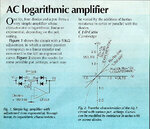neazoi
Advanced Member level 6
Simple transistor logarithmic RF preamplifier for 0-30MHz, to replace the RF (and AF, as it is reflexed) preamplifier in this schematic **broken link removed**
This way I can avoid thr RF preamp from directly rectifying strong out of band stations, without them passing from the regenerative detector.
Can it be done?
Good log performance is not of interest, just a modest performance should be enough.
I have seen the attached circuit with great interest, but this is for audio. I wonder if it can be transformed to discrete components for audio AND RF at the same time.
PS. I am not good in simulators, perhaps one could help more.
This way I can avoid thr RF preamp from directly rectifying strong out of band stations, without them passing from the regenerative detector.
Can it be done?
Good log performance is not of interest, just a modest performance should be enough.
I have seen the attached circuit with great interest, but this is for audio. I wonder if it can be transformed to discrete components for audio AND RF at the same time.
PS. I am not good in simulators, perhaps one could help more.
